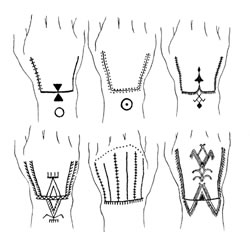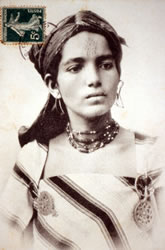Tattooing in North Africa, The Middle East and Balkans
Article © 2010 Lars Krutak
BERBER TATTOOISTS AND THEIR MOTIFS
Although there are hundreds of Berber tribes living throughout northern Africa today, tattoo techniques were largely uniform in the past, as were the choice of pigments (e.g., lampblack). However, the natural products chosen to heal the tattoo wounds were diverse and varied: ashes of watermelon rinds, saffron, henna, crushed belladonna, cabbage leaves, barley, ivy, spittle, and mint among other things. Sometimes these substances enhanced the color of the tattoos, sometimes not, or they contained baraka which added curative power.
|

Protective hand tattoos from Tunisia, ca. 1920. |
Nevertheless, nearly all Berbe rtattooists were women, praised for their knowledge of healing substances and their skill in epidermic artistry. In the High Atlas of Morocco, excerpts from the late 1920s Berber poem Chants de la Tessaout reveal that the tattooist Lalla Taouchamt, “The Madame Tattooer,” was divinely blessed, demonstrating that tattooists were locally recognized and often remembered by their community histories:
Afakem! Afakem! Madame the Tattooer!
In verity, you are incomparable
With both the big and little needle!
You know how to use the pot-black and the ivy so well
That the blue of your tattoos remains for ever
And your designs are unrivaled in the region.
It is well-known, they wrangle over your talent,
All the girls and the women of our villages.
No man gets married without asking you
If it is really your needle which has pricked…
Prick and pat, our beloved tattooer!
May God give you his blessing!
May God overwhelm you with his favours!
Generally speaking, Berbertattoo designs were passed from mother to daughter. Those that were perceived to have medicinal qualities, like the fertility inducing palm tree (nahla) whose origins are grounded in prophylactic magic, were especially reproduced over successive generations.
In the Aurès region of Algeria, the Chaouian Berberstattooed small diamond-shaped lozenges between a child’s eyes to keep the evil eye at bay and even a tattooed wheel was believed to cure cancer. Lozenges of this sort were believed to reflect the evil back towards the person who cast it and were also embroidered on saddle cloth in the Atlas region of Morocco or were tattooed on the arms or forehead of women. They also appear in Berber, Turkish, Kazakh, and Bosnian rugs, arranged in rows along the borders. In other cases, a carding comb was tattooed on weavers to make them more efficient. Among the Kabyle, similar comb designs were tattooed on weavers since they were, as previously noted, considered to be purificatory fire symbols. |
|

Berber woman from Algeria with facial tattooing, ca. 1920. The forehead design is a composite motif perhaps associated with magic that was believed to repel the evil eye. Postcard from the collection of the author. |
For the Kabyle and other Berber peoples, weaving wool was the female activity par excellence. There are other indications that weaving was practically identified with procreation, since Thanslith, the triangular motif with which weaving starts is a fertility symbol. But the loom and the area surrounding it in the house were also believed to be powerful apotropaic spaces. Bourdieu explained that:
by her work on the wool, woman produces the beneficent protection of weaving, whose whiteness symbolizes happiness…The loom, the [primary] instrument of female activity, raised facing the east like a man and like a plough, is at the same time the east of an internal space and has a male value as a symbol of protection. [T]he hearth, the navel of the house (which is identified with the belly of the mother), where the embers smolder in a secret, hidden, female fire, is the domain of the woman of the house, who is invested with total authority in all matters concerning cooking and the management of the food stores. However, in all rites in which they play a part, the fireplace and the stones surrounding it derive their magical power, whether to give protection from the evil eye or from illness, or to bring fine weather, from the fact that they belong to the order of fire...and the heat of the sun.
Nevertheless the loom, a seemingly benign object, was also considered to be a dangerous object which, like the crossroads or the blacksmith, could bring sterility and other misfortune:
The dangerous character of the loom, which combines within itself the two forms of male violence, crossing and cutting, is reinforced by the properties attached to some of its parts, such as ilni (the strings separating the threads of the warp), an ambivalent object, evoking cutting and tying, which is used in rites of malign magic as well as in prophylactic magic. Without telling him, a woman measures her husband with string, ties seven knots in it, takes a piece of one of his old garments, wraps the string in it with a bouquet of asa foetida, often used in expulsion rites, and buries everything in the grave of a stranger or at the boundary between two fields. To measure is to make a double, a substitute for the thing measured and so gain power over it (the reed with which a corpse is measured is always buried at the bottom of the grave to prevent women from making magic use of it). This measuring – that is, cutting – operation, performed with an object associated with cutting and dryness, is also applied to a cow to prevent theft of the milk or to a child in the rites to protect against the evil eye.
Next Page | 1
|
2 |
3 |
4 |
5 |
6 |
7 |
8 |
Museum photo gallery of the images
on this page may be seen here.
|


